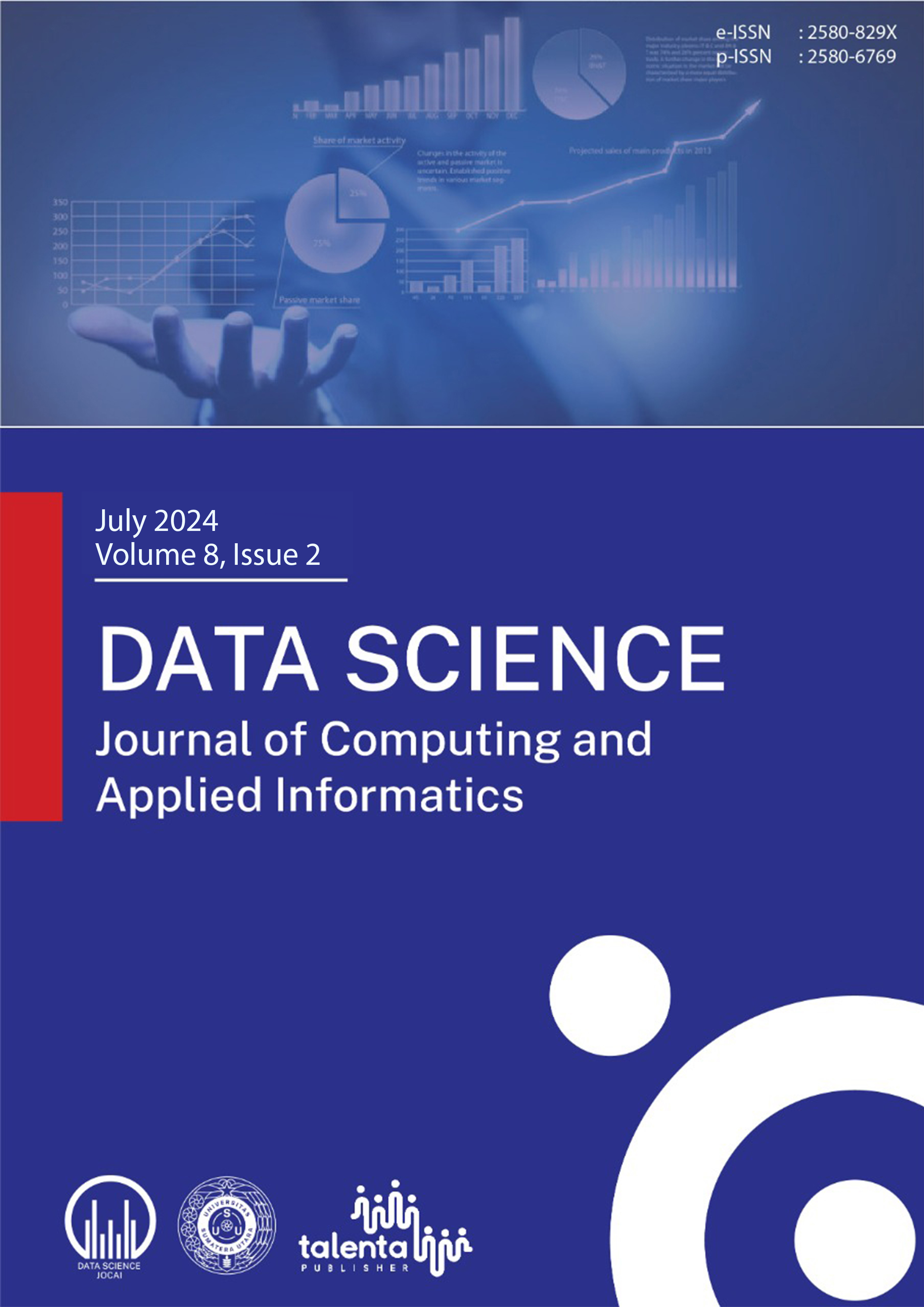Analysis of Employee Work Stress Using CRISP-DM to Reduce Work Stress on Reasons for Employee Resignation
DOI:
https://doi.org/10.32734/jocai.v8.i2-14615Keywords:
Work Stress, Descriptive Analysis, Diagnostic Analysis, K-Modes Clustering, SECIAbstract
Internal audit activities at EPC companies have found a trend of increasing work stress as a reason for employee resignation in the period Q4 2021 - Q1 2023. In implementing ISO 45001:2015 this must be controlled because it is a psychological occupational disease. For this reason, a work stress survey was carried out, the results of which were reviewed using Cross Industry Standard Process for Data Mining (CRISP-DM). Descriptive analysis found a maximum ratio of moderate stress of 66%, light stress of 39%, and severe stress of 9% with a risk matrix in Medium (yellow area). Descriptive analysis found a maximum ratio of moderate stress of 66%, light stress of 39%, and severe stress of 9% with a risk matrix in Medium (yellow area). Diagnostic analysis found a total of 19 questionnaires that affected severe stress and moderate stress. Cluster K-Modes shows 3 clusters being centroids with principal component values explaining around 4.92% of the original feature variance. The deployment of work stress control is carried out through focus group discussion to formulate Socialization, Externalization, Combination, Internalization (SECI) as a follow-up program for organization.
Downloads
References
N. Ghodrati, T. W. Yiu, S. Wilkinson, and M. Shahbazpour, “A new approach to predict safety outcomes in the construction industry,†Saf Sci, vol. 109, pp. 86–94, Nov. 2018, doi: 10.1016/j.ssci.2018.05.016.
H. Alqudah et al., “The impact of empowering internal auditors on the quality of electronic internal audits: A case of Jordanian listed services companies,†International Journal of Information Management Data Insights, vol. 3, no. 2, Nov. 2023, doi: 10.1016/j.jjimei.2023.100183.
Q. Liang, Z. Zhou, G. Ye, and L. Shen, “Unveiling the mechanism of construction workers’ unsafe behaviors from an occupational stress perspective: A qualitative and quantitative examination of a stress–cognition–safety model,†Saf Sci, vol. 145, Jan. 2022, doi: 10.1016/j.ssci.2021.105486.
S. Zhang, R. Y. Sunindijo, S. Frimpong, and Z. Su, “Work stressors, coping strategies, and poor mental health in the Chinese construction industry,†Saf Sci, vol. 159, Mar. 2023, doi: 10.1016/j.ssci.2022.106039.
M. Mavroulidis et al., “Occupational health and safety of multinational construction companies through evaluation of corporate social responsibility reports,†J Safety Res, vol. 81, pp. 45–54, Jun. 2022, doi: 10.1016/j.jsr.2022.01.005.
A. Fernandes, M. Figueiredo, J. Ribeiro, J. Neves, and H. Vicente, “Psychosocial Risks Assessment in Cryopreservation Laboratories,†Saf Health Work, vol. 11, no. 4, pp. 431–442, Dec. 2020, doi: 10.1016/j.shaw.2020.07.003.
V. Golinko, S. Cheberyachko, O. Deryugin, O. Tretyak, and O. Dusmatova, “Assessment of the Risks of Occupational Diseases of the Passenger Bus Drivers,†Saf Health Work, vol. 11, no. 4, pp. 543–549, Dec. 2020, doi: 10.1016/j.shaw.2020.07.005.
W. Umer, “Simultaneous monitoring of physical and mental stress for construction tasks using physiological measures,†Journal of Building Engineering, vol. 46, Apr. 2022, doi: 10.1016/j.jobe.2021.103777.
Kementerian Ketenagakerjaan Republik Indonesia, “Peraturan Menteri Ketenagakerjaan Nomor 5 Tahun 2018 Tentang Keselamaan dan Kesehatan Kerja Lingkungan Kerja,†Jakarta, 2018.
IBM Corporation, “IBM SPSS Modeler CRISP-DM Guide,†Internet News Group.
C. C. & R. C. K. Aggarwal, Data Clustering Algorythms and Applications, 1st ed. Florida: Chapman and Hall/CRC, 2013.
E. B. Ewin Karman Nduru, “Implementasi Algoritma K-Modes Untuk Menentukan Strategi Marketing STMIK Budi Darma,†in Konferensi Nasional Teknologi Informasi dan Komputer, Medan: STMIK Budi Darma, 2018, pp. 12–19.
N. B. Mendoza, E. C. K. Cheng, and Z. Yan, “Assessing teachers’ collaborative lesson planning practices: Instrument development and validation using the SECI knowledge-creation model,†Studies in Educational Evaluation, vol. 73, Jun. 2022, doi: 10.1016/j.stueduc.2022.101139.
A. Lane, “Towards a theory of organizational storytelling for public relations: An engagement perspective,†Public Relat Rev, vol. 49, no. 1, Mar. 2023, doi: 10.1016/j.pubrev.2023.102297.
A. Kemp, R. Gravois, H. Syrdal, and E. McDougal, “Storytelling is not just for marketing: Cultivating a storytelling culture throughout the organization,†Bus Horiz, vol. 66, no. 3, pp. 313–324, May 2023, doi: 10.1016/j.bushor.2023.01.008.
A. M. W. Leong, S.-S. Yeh, Y. Zhou, C.-W. Hung, and T.-C. Huan, “Exploring the influence of historical storytelling on cultural heritage tourists’ value co-creation using tour guide interaction and authentic place as mediators,†Tour Manag Perspect, vol. 50, p. 101198, Jan. 2024, doi: 10.1016/j.tmp.2023.101198.
D. Andino Ardi, K. Ulfah Naila El Muna, D. Dwimartha, and L. Dysi Setiawati, “Gambaran Tingkat Stres pada Pekerja PT. Sucofindo Cabang Surabaya Tahun 2022,†SEHATRAKYAT (Jurnal Kesehatan Masyarakat) , vol. 2, no. 2, pp. 221–228, 2023, doi: 10.54259/sehatrakyat.v2i2.1659.
M. Marchelli, G. Coltrinari, G. Alfaro Degan, and D. Peila, “Towards a procedure to manage safety on construction sites of rockfall protective measures,†Saf Sci, vol. 168, Dec. 2023, doi: 10.1016/j.ssci.2023.106307.
Shashi Kant Sharma, “Guidelines on Data Analytics,†2017.
A. Golzari Oskouei, M. A. Balafar, and C. Motamed, “FKMAWCW: Categorical fuzzy k-modes clustering with automated attribute-weight and cluster-weight learning,†Chaos Solitons Fractals, vol. 153, Dec. 2021, doi: 10.1016/j.chaos.2021.111494.
S. S. Khan and A. Ahmad, “Cluster center initialization algorithm for K-modes clustering,†Expert Syst Appl, vol. 40, no. 18, pp. 7444–7456, 2013, doi: 10.1016/j.eswa.2013.07.002.
R. J. Kuo, Y. R. Zheng, and T. P. Q. Nguyen, “Metaheuristic-based possibilistic fuzzy k-modes algorithms for categorical data clustering,†Inf Sci (N Y), vol. 557, pp. 1–15, May 2021, doi: 10.1016/j.ins.2020.12.051.
Y. Yati, “Idea generation techniques in pop-up tourism labs,†Annals of Tourism Research Empirical Insights, vol. 4, no. 1, May 2023, doi: 10.1016/j.annale.2023.100096.
Downloads
Published
How to Cite
Issue
Section
License
Copyright (c) 2024 Data Science: Journal of Computing and Applied Informatics

This work is licensed under a Creative Commons Attribution-ShareAlike 4.0 International License.















